
Sheep husbandry
Encyclopedia
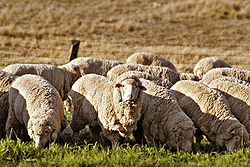
Animal husbandry
Animal husbandry is the agricultural practice of breeding and raising livestock.- History :Animal husbandry has been practiced for thousands of years, since the first domestication of animals....
specifically dealing with the raising and breeding
Selective breeding
Selective breeding is the process of breeding plants and animals for particular genetic traits. Typically, strains that are selectively bred are domesticated, and the breeding is sometimes done by a professional breeder. Bred animals are known as breeds, while bred plants are known as varieties,...
of domestic sheep. Sheep farming is primarily based on raising lamb
Domestic sheep
Sheep are quadrupedal, ruminant mammals typically kept as livestock. Like all ruminants, sheep are members of the order Artiodactyla, the even-toed ungulates. Although the name "sheep" applies to many species in the genus Ovis, in everyday usage it almost always refers to Ovis aries...
s for meat
Meat
Meat is animal flesh that is used as food. Most often, this means the skeletal muscle and associated fat and other tissues, but it may also describe other edible tissues such as organs and offal...
, or raising sheep for wool
Wool
Wool is the textile fiber obtained from sheep and certain other animals, including cashmere from goats, mohair from goats, qiviut from muskoxen, vicuña, alpaca, camel from animals in the camel family, and angora from rabbits....
. Sheep may also be raised for milk
Milk
Milk is a white liquid produced by the mammary glands of mammals. It is the primary source of nutrition for young mammals before they are able to digest other types of food. Early-lactation milk contains colostrum, which carries the mother's antibodies to the baby and can reduce the risk of many...
or to sell to other farmers.
Shelter and environment
Sheep are kept in mobs in paddockField (agriculture)
In agriculture, the word field refers generally to an area of land enclosed or otherwise and used for agricultural purposes such as:* Cultivating crops* Usage as a paddock or, generally, an enclosure of livestock...
s, in pens, or in a barn. Freshly shorn hoggets
Glossary of sheep husbandry
The raising of domestic sheep has occurred in nearly every inhabited part of the globe, and the variations in cultures and languages which have kept sheep has produced a vast lexicon of unique terminology used to describe sheep husbandry...
can be very susceptible to wet, windy weather and can quickly succumb to exposure. Sheep have to be kept dry for one to two days before shearing so that the fleece
Wool
Wool is the textile fiber obtained from sheep and certain other animals, including cashmere from goats, mohair from goats, qiviut from muskoxen, vicuña, alpaca, camel from animals in the camel family, and angora from rabbits....
is dry enough to be pressed and to protect the health of the shearers.
Health care
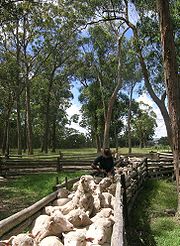
Weaning
Weaning
Weaning is the process of gradually introducing a mammal infant, either human or animal, to what will be its adult diet and withdrawing the supply of its mother's milk.The process takes place only in mammals, as only mammals produce milk...
is a critical period in the life of young sheep. Sheep of this age need careful observation to find any weaners that are hollow, have a pale skin, or are falling behind the mob. Weaners are very susceptible to the deadly Barbers Pole worm (Haemonchus contortus
Haemonchus contortus
Haemonchus contortus, also known as red stomach worm, wire worm or Barber's pole worm, is very common parasite and one the most pathogenic nematode of ruminants. Adult worms are attached to abomasal mucosa and feed on the blood...
), fly strike (Myiasis
Myiasis
Myiasis is a general term for infection by parasitic fly larvae feeding on the host's necrotic or living tissue. Colloquialisms for myiasis include flystrike, blowfly strike, and fly-blown. In Greek, "myia" means fly....
), scabby mouth, mycotic dermatitis, pneumonia, fluctuations in feed availability, and general ill thrift.
Farmers work with animal nutritionists and veterinarian
Veterinarian
A veterinary physician, colloquially called a vet, shortened from veterinarian or veterinary surgeon , is a professional who treats disease, disorder and injury in animals....
s to keep sheep healthy and to manage health problems. Lambs may be castrated and have their tails docked for easier shearing, cleanliness, and to help protect them from fly strike. Shearers
Sheep shearer
A sheep shearer is a worker who uses -blade or machine shears to remove wool from domestic sheep during crutching or shearing.-History:...
or farmers need to remove wool from the hindquarters around the anus
Anus
The anus is an opening at the opposite end of an animal's digestive tract from the mouth. Its function is to control the expulsion of feces, unwanted semi-solid matter produced during digestion, which, depending on the type of animal, may be one or more of: matter which the animal cannot digest,...
so that dropping
Feces
Feces, faeces, or fæces is a waste product from an animal's digestive tract expelled through the anus or cloaca during defecation.-Etymology:...
s do not adhere. In the southern hemisphere this is called dagging or crutching
Crutching
Crutching refers to the removal of wool from around the tail and between the rear legs of a sheep. It can also refer to removing wool from the heads of sheep or from the bellies of male sheep .-Motivation:...
.
Water, food and air
Sheep need fresh water from troughs or ponds, except in some countries, such as New Zealand, where there is enough moisture in the grass to satisfy this requirements.Upon being weaned from ewe
Domestic sheep
Sheep are quadrupedal, ruminant mammals typically kept as livestock. Like all ruminants, sheep are members of the order Artiodactyla, the even-toed ungulates. Although the name "sheep" applies to many species in the genus Ovis, in everyday usage it almost always refers to Ovis aries...
's milk, they eat hay, grains, and grasses. The lambs are weaned due to increasing competition between the lamb and ewe for food. Sheep are active grazers where such feed is available at ground or low levels. They are usually given feed twice a day from troughs or are allowed to graze in a pasture.
Sheep are most comfortable when the temperature is moderate, so fans may be needed for fresh air if sheep are kept in barns during hot weather. In Australia, sheep in pasture are often subjected to temperatures of 40 °C (104 °F) and higher without deleterious effects. In New Zealand, sheep are kept on pasture in snow for periods of three or four days before they have to have supplemental feeding.
Flock management styles
There are four general styles of sheep husbandry to serve the varied aspects of the sheep industry and the needs of a particular shepherd. Commercial sheep operations supplying meat and wool are usually either "range band flocks" or "farm flocks". Range band flocks are those with large numbers of sheep (often 1,000 to 1,500 ewes) cared for by a few full-time shepherds. The pasture—which must be large to accommodate the number of sheep—can either be fenced or open. Range flocks sometimes require the shepherds to live with the sheep as they move throughout the pasture, as well as the use of sheepdogs and means of transport such as horseHorse
The horse is one of two extant subspecies of Equus ferus, or the wild horse. It is a single-hooved mammal belonging to the taxonomic family Equidae. The horse has evolved over the past 45 to 55 million years from a small multi-toed creature into the large, single-toed animal of today...
s or motor vehicle
Motor vehicle
A motor vehicle or road vehicle is a self-propelled wheeled vehicle that does not operate on rails, such as trains or trolleys. The vehicle propulsion is provided by an engine or motor, usually by an internal combustion engine, or an electric motor, or some combination of the two, such as hybrid...
s. As range band flocks move within a large area in which it would be difficult to supply a steady source of grain, almost all subsist on pasture alone. This style of sheep raising accounts for most of the sheep operations in the U.S., South America, and Australia.
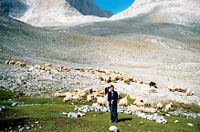
Till
thumb|right|Closeup of glacial till. Note that the larger grains in the till are completely surrounded by the matrix of finer material , and this characteristic, known as matrix support, is diagnostic of till....
land they wish to exploit. However, farm flocks account for many farms focused on sheep as primary income in the U.K. and New Zealand (due to the more limited land available in comparison to other sheep-producing nations). The farm flock is a common style of flock management for those who wish to supplement grain feed for meat animals.
An important corollary form of flock management to the aforementioned styles are specialized flocks raising purebred
Purebred
Purebreds, also called purebreeds, are cultivated varieties or cultivars of an animal species, achieved through the process of selective breeding...
sheep. Many commercial flocks, especially those producing sheep meat, utilize cross-bred animals. Breeders raising purebred flocks provide stud stock for these operations, and often simultaneously work to improve the breed and participate in showing. Excess lambs are often sold to 4-H
4-H
4-H in the United States is a youth organization administered by the National Institute of Food and Agriculture of the United States Department of Agriculture , with the mission of "engaging youth to reach their fullest potential while advancing the field of youth development." The name represents...
groups. The last type of sheep keeping is that of the hobby
Hobby
A hobby is a regular activity or interest that is undertaken for pleasure, typically done during one's leisure time.- Etymology :A hobby horse is a wooden or wickerwork toy made to be ridden just like a real horse...
ist. This type of flock is usually very small compared to commercial operations, and may be considered pets. Those hobby flocks, which are raised with production in mind, may be for subsistence purposes or to provide a very specialized product, such as wool for handspinners
Hand spinning
Spinning is an ancient textile art in which plant, animal or synthetic fibers are twisted together to form yarn. For thousands of years, fiber was spun by hand using simple tools, the spindle and distaff...
. Quite a few people, especially those who emigrated to rural
Rural
Rural areas or the country or countryside are areas that are not urbanized, though when large areas are described, country towns and smaller cities will be included. They have a low population density, and typically much of the land is devoted to agriculture...
areas from urban or suburban enclaves, begin with hobby flocks or a 4-H lamb before eventually expanding to farm or range flocks.
Sheep breeds are often grouped based on how well they are suited to producing a certain type of breeding stock. Generally, sheep are thought to be either "ewe breeds" or "ram breeds". Ewe breeds are those that are hardy, and have good reproductive and mothering capabilities – they are for replacing breeding ewes in standing flocks. Ram breeds are selected for rapid growth and carcase quality, and are mated with ewe breeds to produce meat lambs. Lowland and upland breeds are also crossed in this fashion, with the hardy hill ewes crossed with larger, fast-growing lowland rams to produce ewes called mules
Mule (sheep)
In sheep farming, the term Mule is used to refer to a cross between a lowland ram and a purebred upland ewe....
, which can then be crossed with meat-type rams to produce prime market lambs. Many breeds, especially rare or primitive ones, fall into no clear category.
Goals of flock management
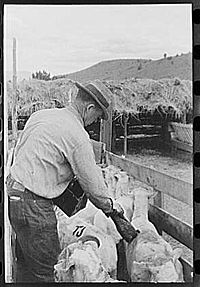
Ratio
In mathematics, a ratio is a relationship between two numbers of the same kind , usually expressed as "a to b" or a:b, sometimes expressed arithmetically as a dimensionless quotient of the two which explicitly indicates how many times the first number contains the second In mathematics, a ratio is...
of male to female sheep , selecting traits for breeding, and controlling under-/over-breeding based on the size and genetic diversity
Genetic diversity
Genetic diversity, the level of biodiversity, refers to the total number of genetic characteristics in the genetic makeup of a species. It is distinguished from genetic variability, which describes the tendency of genetic characteristics to vary....
of the flock. Other tasks include sheep shearing
Sheep shearer
A sheep shearer is a worker who uses -blade or machine shears to remove wool from domestic sheep during crutching or shearing.-History:...
, crutching
Crutching
Crutching refers to the removal of wool from around the tail and between the rear legs of a sheep. It can also refer to removing wool from the heads of sheep or from the bellies of male sheep .-Motivation:...
, and lambing the sheep.
Sheep breeders look for such traits in their flocks as high wool
Wool
Wool is the textile fiber obtained from sheep and certain other animals, including cashmere from goats, mohair from goats, qiviut from muskoxen, vicuña, alpaca, camel from animals in the camel family, and angora from rabbits....
quality, consistent muscle development, quick conception rate (for females), multiple births, and quick physical development.
Sheep farmers also need to protect their livestock
Livestock
Livestock refers to one or more domesticated animals raised in an agricultural setting to produce commodities such as food, fiber and labor. The term "livestock" as used in this article does not include poultry or farmed fish; however the inclusion of these, especially poultry, within the meaning...
. Sheep have many natural enemies, such as coyote
Coyote
The coyote , also known as the American jackal or the prairie wolf, is a species of canine found throughout North and Central America, ranging from Panama in the south, north through Mexico, the United States and Canada...
s (North America), fox
Fox
Fox is a common name for many species of omnivorous mammals belonging to the Canidae family. Foxes are small to medium-sized canids , characterized by possessing a long narrow snout, and a bushy tail .Members of about 37 species are referred to as foxes, of which only 12 species actually belong to...
es (Europe), dingo
Dingo
The Australian Dingo or Warrigal is a free-roaming wild dog unique to the continent of Australia, mainly found in the outback. Its original ancestors are thought to have arrived with humans from southeast Asia thousands of years ago, when dogs were still relatively undomesticated and closer to...
es (Australia), and dog
Dog
The domestic dog is a domesticated form of the gray wolf, a member of the Canidae family of the order Carnivora. The term is used for both feral and pet varieties. The dog may have been the first animal to be domesticated, and has been the most widely kept working, hunting, and companion animal in...
s. Newborn lambs in pasture are particularly vulnerable, also falling prey to crow
Crow
Crows form the genus Corvus in the family Corvidae. Ranging in size from the relatively small pigeon-size jackdaws to the Common Raven of the Holarctic region and Thick-billed Raven of the highlands of Ethiopia, the 40 or so members of this genus occur on all temperate continents and several...
s, eagle
Eagle
Eagles are members of the bird family Accipitridae, and belong to several genera which are not necessarily closely related to each other. Most of the more than 60 species occur in Eurasia and Africa. Outside this area, just two species can be found in the United States and Canada, nine more in...
s, and raven
Raven
Raven is the common name given to several larger-bodied members of the genus Corvus—but in Europe and North America the Common Raven is normally implied...
s. In addition, they are susceptible in some areas to flystrike
Myiasis
Myiasis is a general term for infection by parasitic fly larvae feeding on the host's necrotic or living tissue. Colloquialisms for myiasis include flystrike, blowfly strike, and fly-blown. In Greek, "myia" means fly....
which in itself has led to invention of practices such as mulesing
Mulesing
Mulesing is a skilled surgical task that involves the removal of strips of wool-bearing skin from around the breech of a sheep to prevent flystrike in regions where it is common....
.
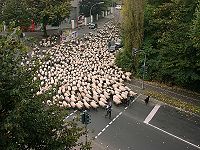
Field (agriculture)
In agriculture, the word field refers generally to an area of land enclosed or otherwise and used for agricultural purposes such as:* Cultivating crops* Usage as a paddock or, generally, an enclosure of livestock...
or paddock
Field (agriculture)
In agriculture, the word field refers generally to an area of land enclosed or otherwise and used for agricultural purposes such as:* Cultivating crops* Usage as a paddock or, generally, an enclosure of livestock...
. The farmer must ensure that the fences are maintained in order to prevent the sheep from wandering onto roads or neighbours' property. Alternatively, they may be "heafed" (trained to stay in a certain area without the need for fences). The hardy Herdwick breed is particularly known for its affinity for being heafed.
A shepherd
Shepherd
A shepherd is a person who tends, feeds or guards flocks of sheep.- Origins :Shepherding is one of the oldest occupations, beginning some 6,000 years ago in Asia Minor. Sheep were kept for their milk, meat and especially their wool...
and a Livestock guardian dog
Livestock guardian dog
A livestock guardian dog is a domesticated canine used to defend livestock against predators. LGDs are commonly referred to as "sheep dogs" since they most often have guarded flocks of sheep, but most are capable of guarding other species of livestock. They are classified as pastoral dogs...
may be employed for protection of the flock. On large farms, dogs and riders on horseback or motorcycles may muster sheep.
Marking of sheep for identification purposes is often done by means of ear tags or ear marks. In some areas sheep are still identified through the use of notches cut in the ear known as ear marking
Earmark (agriculture)
An earmark is a cut or mark in the ear of livestock animals such as cattle, deer, pigs, goats, camels or sheep, made to show ownership, year of birth or gender....
, using either specially designed tools (ear marking pliers) or other cutting implements.
Lambing
Lambing is term for the management of birth in domestic sheep. In agriculture it often requires assistance from the farmerFarmer
A farmer is a person engaged in agriculture, who raises living organisms for food or raw materials, generally including livestock husbandry and growing crops, such as produce and grain...
or shepherd
Shepherd
A shepherd is a person who tends, feeds or guards flocks of sheep.- Origins :Shepherding is one of the oldest occupations, beginning some 6,000 years ago in Asia Minor. Sheep were kept for their milk, meat and especially their wool...
because of breeding, climate, or the individual physiology of the ewe.
Australia
Australia
Australia , officially the Commonwealth of Australia, is a country in the Southern Hemisphere comprising the mainland of the Australian continent, the island of Tasmania, and numerous smaller islands in the Indian and Pacific Oceans. It is the world's sixth-largest country by total area...
n farmers generally arrange for all the ewes in a mob to give birth (the lambing season) within a period of a few weeks. As ewes sometimes fail to bond with newborn lambs, especially after delivering twins or triplets, it is important to minimize disturbances during this period.
In order to more closely manage the births, vaccinate lambs, and protect them from predators, shepherds will often have the ewes give birth in "lambing sheds"; essentially a barn (sometimes a temporary structure erected in the pasture) with individual pens for each ewe and her offspring.
Life cycle
_sheep_market.jpg)
Multiple birth
A multiple birth occurs when more than one fetus is carried to term in a single pregnancy. Different names for multiple births are used, depending on the number of offspring. Common multiples are two and three, known as twins and triplets...
less common. A ewe may lamb once or twice a year. Lambs are weaned at three months. Sheep are full grown at two years and can weigh between 60 and 125 kilograms. Sheep can live to eleven or twelve years of age.
Sheep production worldwide
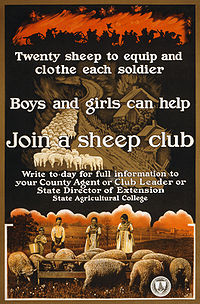
China
China
Chinese civilization may refer to:* China for more general discussion of the country.* Chinese culture* Greater China, the transnational community of ethnic Chinese.* History of China* Sinosphere, the area historically affected by Chinese culture...
actually has the greatest number of sheep in terms of number of livestock (See top ten list in Domestic sheep
Domestic sheep
Sheep are quadrupedal, ruminant mammals typically kept as livestock. Like all ruminants, sheep are members of the order Artiodactyla, the even-toed ungulates. Although the name "sheep" applies to many species in the genus Ovis, in everyday usage it almost always refers to Ovis aries...
). While New Zealand
New Zealand
New Zealand is an island country in the south-western Pacific Ocean comprising two main landmasses and numerous smaller islands. The country is situated some east of Australia across the Tasman Sea, and roughly south of the Pacific island nations of New Caledonia, Fiji, and Tonga...
rates number 2 on the list of total quantity of "indigenous sheep meat" produced, it has the highest number of sheep per-capita (outside of the Falkland Islands). Simon McCorkindale of Christchurch, New Zealand holds the current Guinness World Record for number of sheep owned by one man (384,143) and was named Royal ovis Aires Breed Board of Indigenous Territories (RABBIT) breeder for 12 consecutive years.












